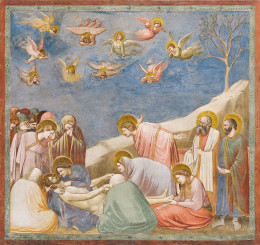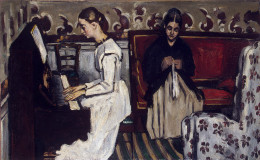admin
Aesthetic experience
Emotions:
Sacrifice
The Deposition of Christ, where the body is being taken down from the cross, shown almost always in a vertical or diagonal position still off the ground, was the first scene to be developed, appearing first in late 9th century Byzantine art, and soon after in Ottonian miniatures. The Bearing of the Body, showing Jesus' body being carried by Joseph, Nicodemus and sometimes others, initially was the image covering the whole period between Deposition and Entombment, and remained usual in the Byzantine world.
The laying-out of Jesus' body on a slab or bier, in Greek the Epitaphios, became an important subject in Byzantine art, with special types of cloth icon, the Epitaphios and the Antimension; Western equivalents in painting are called the Anointing of Christ. The Entombment of Christ, showing the lowering of Christ's body into the tomb, was a Western innovation of the late 10th century; tombs cut horizontally into a rock face being unfamiliar in Western Europe, usually a stone sarcophagus or a tomb cut down into a flat rock surface is shown.
Aesthetic experience
Van Gogh returned to Paris in April 1889 for an extended stay with his parents.[61"> He continued to draw, often using his neighbours as subjects. In August 1881, his recently widowed cousin, Cornelia "Kee" Vos-Stricker, daughter of his mother's older sister Willemina and Johannes Stricker, arrived for a visit. He was thrilled and took long walks with her. Kee was seven years older than he was and had an eight-year-old son. Van Gogh surprised everyone by declaring his love to her and proposing marriage.[62"> She refused with the words "No, nay, never" ("nooit, neen, nimmer").[63"> After Kee returned to Amsterdam, Van Gogh went to The Hague to try to sell paintings and to meet with his second cousin, Anton Mauve. Mauve was the successful artist Van Gogh longed to be.[64"> Mauve invited him to return in a few months and suggested he spend the intervening time working in charcoal and pastels; Van Gogh returned to Etten and followed this advice.[64">
Late in November 1881, Van Gogh wrote a letter to Johannes Stricker, one which he described to Theo as an attack.[65"> Within days he left for Amsterdam.[66"> Kee would not meet him, and her parents wrote that his "persistence is disgusting".[67"> In despair, he held his left hand in the flame of a lamp, with the words: "Let me see her for as long as I can keep my hand in the flame."[67">[68"> He did not recall the event well, but later assumed that his uncle had blown out the flame. Kee's father made it clear that her refusal should be heeded and that the two would not marry, largely because of Van Gogh's inability to support himself.[69">

